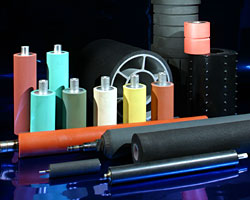 Cylinder linings Cylinder linings
Manufacturing process
The lining of cylinders (or rollers or rolls) consists in covering part of a metal or composite axle (often known as a table) with an elastomer. Certain cylinders also require the lining of the journal axles (spindles) and the end plates (sides of the table).
The operations described in a synthetic manner in the following diagram describe the process used.
Materials
The materials used for lining cylinders are selected from the complete range of formulae available to S.E.E. Their choice depends on the final use (see elastomer applications table and cylinder series).
A wide range of formulations has been developed specifically for cylinder lining applications.
Uses
The principal users of lined cylinders are:
- the metallurgical industry (treatment of metal sheets)
- the paper industry (manufacture of paper, cardboard, packaging, cutting)
- printing
- textiles
- tanning
- plastic films
- wood
- office equipment (photocopiers, faxes, printers, etc.)
Each industry uses specific cylinders and rolls
- compression rolls
- mangle rolls
- applicator rolls
- lacquer cylinders
- varnish cylinders
- ink cylinders
- embossing cylinders
- tractor cylinders
- S block cylinders
- feed rolls
- conveyor rolls
- rollers
- transfer rolls
- deflector rolls
- scrimp roller cylinders
- sizing rolls
- immersion rolls
- etc...
S.E.E.’s capabilities
S.E.E. develops an appropriate solution for each type of cylinder and each user.
We can offer a range of hardnesses from 20 Shore A to 85 Shore D.
S.E.E. is equipped for lining cylinders ranging from the smallest up to diameters of 1000 mm and 6000 mm overall length.
We use all of the manufacturing techniques described and can develop specific formulations for your requirements.
|

